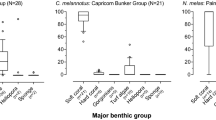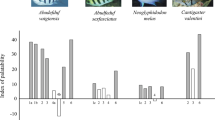Abstract
Coral-dwelling gobies in the genus Gobiodon (family Gobiidae) posses toxic skin secretions. We used bioassays to investigate interspecific variation in the toxicity of skin secretions from six species of Gobiodon from Lizard Island on the Great Barrier Reef. We then used feeding experiments with two common species of predatory fish to test if skin secretions might act as a chemical defence against predation. The skin secretions of all species were toxic to the bioassay species, Apogon fragilis, but there were marked differences in toxicity among Gobiodon species. Feeding experiments showed that both small- and large-gaped predators avoided food items to which goby skin secretions, or a whole goby, had been added. These experiments indicate that skin toxins could function as a predator deterrent in coral-dwelling gobies.
Similar content being viewed by others
References
Bakus, G.J. 1981. Chemical defence mechanisms in the Great Barrier Reef, Australia. Science 211: 951-953.
Bakus, G.J., N.M. Targett & B.A. Schulte. 1986. Chemical ecology of marine organisms: An overview. J. Chem. Ecol. 12: 951-987.
Bobzin, S.C. & D.J. Faulkner. 1992. Chemistry and chemical ecology of the Bahamian sponge Aplysilla glacialis. J. Chem. Ecol. 18: 309-332.
Bryan, P.J., J.B. McClintock & T.S. Hopkins. 1997. Structural and chemical defences of echinoderms from the northern Gulf of Mexico. J. Exp. Mar. Biol. Ecol. 210: 173-186.
Caley, M.J. 1993. Predation, recruitment and the dynamics of communities of coral-reef fishes. Mar. Biol. 117: 33-43.
Caley, M.J. 1995. Reef-fish community structure and dynamics: An interaction between local and larger-scale processes? Mar. Ecol. Prog. Ser. 129: 19-29.
Cameron, A.M. 1974. Toxicity phenomenon in coral reef waters. Proc. 2nd Int. Coral Reef Symp. 1: 513-518.
Cameron, A.M. & R. Endean. 1973. Epidermal secretions and the evolution of venom glands in fishes. Toxicon 11: 401-410.
Coll, J.C. & P.W. Sammarco. 1983. Terpenoid toxins of soft corals (Cnidaria, Octocorallia): Their nature, toxicity, and ecological significance. Toxicon Suppl 3: 69-72.
Duffy, J.E. & M.E. Hay. 2001. The ecology and evolution of marine consumer-prey interactions. pp. 131-151. In: M.D. Bertness, S.D. Gaines & M.E. Hay (ed.) Marine community ecology, Sinauer Associates, Sunderland.
Forrester, G.E. 1995. Strong density-dependent survival and recruitment regulate the abundance of a coral reef fish. Oecologia 103: 275-282.
Gladstone, W. 1987. The eggs and larvae of the sharp-nose pufferfish Canthigaster valenteni (Pisces: Tetraodontidae) are unpalatable to other reef fishes. Copeia 1997: 227-230.
Gladstone, W. & M. Westoby. 1988. Growth and reproduction in pufferfish Canthigaster valenteni (Pisces: Tetraodontidae): A comparison of a toxic reef fish with other reef fishes. Env. Biol. Fish. 21: 207-221.
Godin, J.J. 1997. Evading predators. pp. 191-236. In: J.J. Godin (ed.) Behavioural ecology of teleost fishes, Oxford University Press, Oxford.
Goldberg, A.S., A.M. Duffield & K.D. Barrow. 1988. Distribution and chemical composition of the toxic skin secretions from trunkfish (Family Ostraciidae). Toxicon 26: 651-663.
Gunthorpe, L. & A.M. Cameron. 1990. Widespread but variable toxicity in scleractinian corals. Toxicon 28: 1199-1219.
Halstead, B.W. 1967. Poisonous and venomous marine animals of the World. US Government Printing Office, Washington DC.
Hashimoto, Y., K. Shiomi & K. Aida. 1974. Occurrence of a skin toxin in coral-gobies Gobiodon spp. Toxicon 12: 523-528.
Hay, M.E. 1991. Fish-seaweed interactions on coral reefs: Effects of herbivorous fishes and adaptations of their prey. pp. 96-119. In: P.F. Sale (ed.) The ecology of fishes on coral reefs, Academic Press, San Diego.
Hay, M.E. 1996. Marine chemical ecology: What's known and what's next. J. Exp. Mar. Biol. Ecol. 200: 103-134.
Hay, M.E. & W. Fenical. 1988. Marine plant-herbivore interactions: The ecology of chemical defence. Ann. Rev. Ecol. Syst. 19: 111-145.
Herms, D.A. & W.J. Mattson. 1992. The dilemma of plants: To grow or defend. Quart. Rev. Biol. 67: 283-335.
Hixon, M.A. 1991. Predation as a process structuring coral reef fish communities. pp. 475-508. In: P.F. Sale (ed.) The Ecology of Fishes on Coral Reefs, Academic Press, San Diego.
Hixon, M.A. & M.H. Carr. 2000. Synergistic predation, density dependence, and population regulation in marine fish. Science 277: 946-949.
Kalmanzon, E., E. Zlotkin & R. Aknin-Herrmann. 1999. Proteinsurfactant interactions in the defensive skin secretion of the Red Sea trunkfish Ostracion cubicus. Mar. Biol. 135: 141-146.
Kalmanzon, E. & E. Zlotkin. 2000. An ichthyotoxic protein in the defensive skin secretion of the Red Sea trunkfish Ostracion cubicus. Mar. Biol. 136: 471-476.
La Barre, S., J.C. Coll & P.W. Sammarco. 1986. Defensive strategies of soft corals (Coelenterata: Octocorallia) of the Great Barrier Reef. II. The relationship between toxicity and feeding deterrence. Biol. Bull. 171: 565-576.
Lassig, B.R. 1981. Significance of the epidermal icthyotoxic secretion of coral-dwelling gobies. Toxicon 19: 729-735.
Lindquist, N. & M.E. Hay. 1996. Palatability and chemical defence of marine invertebrate larvae. Ecol. Monogr. 66: 431-450.
Lubchenco, J. & S.D. Gaines. 1981. A unified approach to marine plant-herbivore interactions. I. Populations and communities. Ann. Rev. Ecol. Syst. 12: 405-437.
Munday, P.L. 2002. Bi-directional sex change: testing the growth-rate advantage model: Behav. Ecol. Sociobiol. 52: 247-254.
Munday, P.L. & S.K. Wilson. 1997. Comparative efficacy of clove oil and other chemicals in anaesthetization of Pomacentrus amboinensis, a coral reef fish. J. Fish. Biol. 51: 931-938.
Munday, P.L., A.S. Harold & R. Winterbottom. 1999. Guide to coral-dwelling gobies, genus Gobiodon (Gobiidae), from Papua New Guinea and the Great Barrier Reef. Revue fr. Aquariol. 26: 53-58.
Munday, P.L., G.P. Jones & M.J. Caley. 1997. Habitat specialisation and the distribution and abundance of coral-dwelling gobies. Mar. Ecol. Prog. Ser. 152: 227-239.
Munday, P.L., G.P. Jones & M.J. Caley. 2001. Interspecific competition and coexistence in a guild of coral-dwelling fishes. Ecology 82: 2177-2189.
Parrish, P.R. 1985. Acute toxicity tests. pp. 31-57. In: G.M. Rand & S.R. Petrocelli (ed.) Fundamentals of Aquatic Toixicology, Hemisphere Publishing Corporation.
Paul, V.J. 1992. Ecological roles of marine natural products. Comstock Publishing Associates, New York.
Paul, V.J. & S.C. Pennings. 1991. Diet-derived chemical defences in the sea hare Stylochelius longicauda J. Mar. Biol. Ecol. 151: 227-243.
Pawlik, J.R., B. Chanas, R.J. Toonen & W. Fenical. 1995. Defences of Caribbean sponges against predatory reef fish. I. Chemical deterrency. Mar. Ecol. Prog. Ser. 127: 183-194.
Primor, N. & E. Zlotkin. 1975. On the ichthyotoxic and hemolytic action of the skin secretion of the flatfish Pardachirus marmoratus (Soleidae). Toxicon 13: 227-231.
Proksch, P. 1994. Defensive roles for secondary metabolites from marine sponges and sponge-feeding nudibranchs. Toxicon 32: 639-655.
Randall, J.E., G.R. Allen & R.C. Steene. 1990. Fishes of the Great Barrier Reef and Coral Sea. Crawford House, Bathurst.
Rhoades, D.F. & R.G. Cates. 1976. Toward a general theory of plant antiherbivore chemistry. Rec. Adv. Phytochem. 10: 168-213.
Stachowicz, J.J. & N. Lindquist. 2000. Hydroid defences against predators: The importance of secondary metabolites versus nematocycts. Oecologia 124: 280-288.
Steinberg, P.D. 1985. Feeding preferences of Tegula funebralis and chemical defences of marine brown algae. Ecol. Monogr. 55: 333-349.
Tachibana, K., M. Sakaitani & K. Nakanishi. 1984. Pavoninins: Shark-repelling ichthyotoxin from the defence secretion of the Pacific sole. Science 226: 703-705.
Thomson, D.A. 1964. Ostracitoxin: An ichthyotoxic stress secretion of the boxfish, Ostracion lentiginosus. Science 146: 244.
Van Alstyne, K.L., C.R. Wylie & V.J. Paul. 1994. Antipredator defences in Pacific soft corals (Coelenterata: Alcyonacea) II. The relative importance of chemical and structural defences in three species of Sinularia. J. Exp. Mar. Biol. Ecol. 178: 17-34.
Veron, J.E.N. 1986. Corals of Australia and the Indo-Pacific. University of Hawaii Press, Honolulu.
Author information
Authors and Affiliations
Corresponding author
Rights and permissions
About this article
Cite this article
Schubert, M., Munday, P.L., Caley, M.J. et al. The Toxicity of Skin Secretions from Coral-Dwelling Gobies and their Potential Role as a Predator Deterrent. Environmental Biology of Fishes 67, 359–367 (2003). https://doi.org/10.1023/A:1025826829548
Issue Date:
DOI: https://doi.org/10.1023/A:1025826829548




